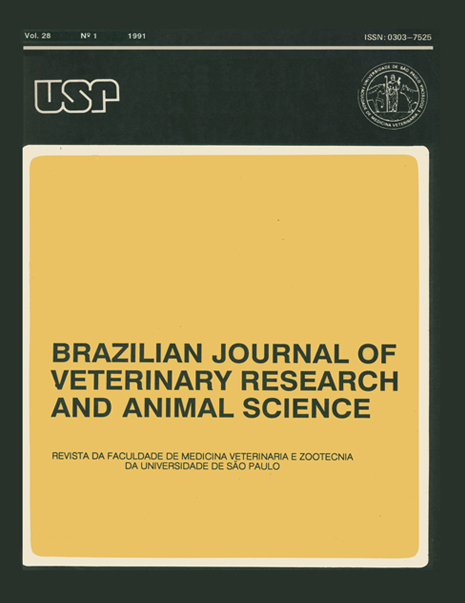Hepatic veins and liver segmentation in ovine (Ovis aries)
DOI:
https://doi.org/10.11606/issn.1678-4456.bjvras.1991.51920Keywords:
Anatomy of sheep, Liver, VeinsAbstract
The hepatic veins and their sectors of drainage have been studied in 40 livers of ovines. In 35 organs the venous system was injected with "Neoprene Latex 650" and then dissected; in the other 5 it was injected with vinyl acetate (different colors) in order to obtain plastic models. The authors observed that hepatic lobes and their sectors were drained by the following hepatic veins and their tributaries. Major hepatic veins (left hepatic vein, middle hepatic vein, right hepatic vein(s), hepatic vein of the caudate process and hepatic vein of the papillary process), and minor hepatic veins. The left and the middle hepatic veins were the main vessels to drain the blood from the liver of Ovis aries and ended independently into the caudal vena cava. The right hepatic vein(s) terminated in the caudal vena cava only in 57.1% of the cases as it joined the vein of the caudate process or of the papillary process in 31.4% one or more right hepatic vein(s) occurred in 88.6% of the cases, a single vein being more frequent (51.4%) than two (22.9%) or three (14.3%) veins. In a few cases the vein of the caudate process formed a trunk with the right hepatic vein and/or the vein of the papillary process (11.4%). Alone or in conjunction with others the vein of the caudate process terminated into the caudal vena cava. The vein of the papillary process ended independently into the caudal vena cava, in 71.4% of the cases. Alone or in conjunction with the vein of the caudate process and/or the right hepatic vein, it ended into the caudal vena cava. Minor hepatic vein, opening directly into the caudal vena cava, completed the drainage of the dorsal and medial sectors of the right lobe and the supraportal portion of the caudate lobe. In the vast majority of cases there were no large anastomoses between veins of adjacent anatomicsurgical segments, limited by avascular or paucivascular areas. The venous drainage network was independent and intertwined with the portobilioarterial network. The venous drainage network included in the majority of cases the following anatomicsurgical segments: a) segment of the left hepatic vein (left lobe); b) segment of the middle hepatic vein (quadrate lobe, the supraportal portion of the caudate lobe, the lateral and intermediate sectors of the right lobe; c) segment of the right hepatic vein(s), typically represented by the dorsal sector of the right lobe; d) segment of the vein of the caudate process; e) segment of the vein of the papillary process. The medial sector of the right lobe is drained by the minor hepatic veins.
Downloads
Downloads
Published
Issue
Section
License
The journal content is authorized under the Creative Commons BY-NC-SA license (summary of the license: https://





